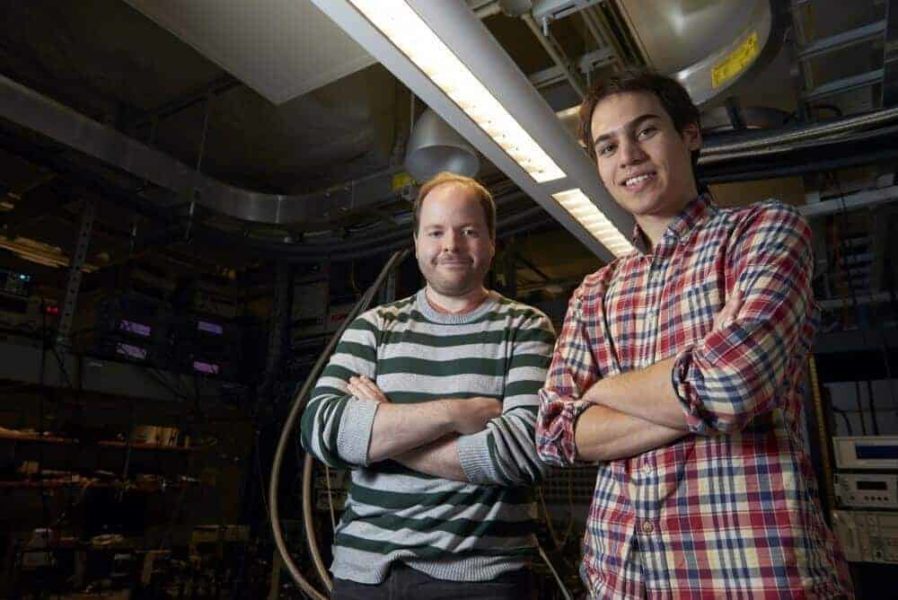A team of scientists from the University of Chicago and Penn State University has accidentally discovered a new way of using light to draw and erase quantum-mechanical circuits in a unique class of materials called topological insulators.
In contrast to using advanced nanofabrication facilities based on chemical processing of materials, this flexible technique allows for rewritable “optical fabrication” of devices. This finding is likely to spawn new developments in emerging technologies such as low-power electronics based on the spin of electrons or ultrafast quantum computers. The research was published Oct. 9 in the American Association for the Advancement of Science’s new online journal Science Advances.
“This observation came as a complete surprise,” said David D. Awschalom, the Liew Family Professor and deputy director in the Institute of Molecular Engineering at UChicago, who was one of two lead researchers on the project. “It’s one of those rare moments in experimental science where a seemingly random event—turning on the room lights—generated unexpected effects with potentially important impacts in science and technology.”
The electrons in topological insulators have unique quantum properties that many scientists believe will be useful for developing spin-based electronics and quantum computers. However, making even the simplest experimental circuits with these materials has proved difficult because traditional semiconductor engineering techniques tend to destroy their fragile quantum properties. Even a brief exposure to air can reduce their quality.
In Science Advances, the researchers report the discovery of an optical effect that allows them to “tune” the energy of electrons in these materials using light, and without ever having to touch the material itself. They have used it to draw and erase p-n junctions—one of the central components of a transistor—in a topological insulator for the first time.
Like many advances in science, the path to this discovery had an unexpected twist.
“To be honest, we were trying to study something completely different,” said Andrew Yeats, a graduate student in Awschalom’s laboratory and the paper’s lead author. “There was a slow drift in our measurements that we traced to a particular type of fluorescent lights in our lab. At first we were glad to be rid of it, and then it struck us—our room lights were doing something that people work very hard to do in these materials.”
The researchers went back to Bulley & Andrews Construction, the contractor that renovated the lab space, for more information about the lights. “I’ve never had a client so obsessed with the overhead lighting,” said Frank Floss, superintendent for Bulley & Andrews. “I could have never imagined how important it would turn out to be.”
The researchers found that the surface of strontium titanate, the substrate material on which they had grown their samples, becomes electrically polarized when exposed to ultraviolet light, and their room lights happened to emit at just the right wavelength. The electric field from the polarized strontium titanate was leaking into the topological insulator layer, changing its electronic properties.
Awschalom and his colleagues found that by intentionally focusing beams of light on their samples, they could draw electronic structures that persisted long after the light was removed.
“It’s like having a sort of quantum Etch A Sketch in our lab,” he said. They also found that bright red light counteracted the effect of the ultraviolet light, allowing them to both write and erase. “Instead of spending weeks in the cleanroom and potentially contaminating our materials,” said Awschalom, “now we can sketch and measure devices for our experiments in real time. When we’re done, we just erase it and make something else. We can do this in less than a second.”
To test whether the new technique might interfere with the unique properties of topological insulators, the team measured their samples in high magnetic fields. They found promising signatures of an effect called weak anti-localization, which arises from quantum interference between the different simultaneous paths that electrons can take through a material when they behave as waves.
“One exciting aspect of this work is that it’s noninvasive,” said Prof. Nitin Samarth, the George A. and Margaret M. Downsbrough Department Head of Physics at Penn State, and a lead researcher on the project. “Since the electrical polarization occurs in an adjacent material, and the effect persists in the dark, the topological insulator remains relatively undisturbed. With these fragile quantum materials, sometimes you have to use a light touch.”
To better understand the physics behind the effect, the researchers conducted a number of control measurements. They showed that the optical effect is not unique to topological insulators, but that it can act on other materials grown on strontium titanate as well.
“In a way, the most exciting aspect of this work is that it should be applicable to a wide range of nanoscale materials such as complex oxides, graphene and transition metal dichalcogenides,” said Awschalom. “It’s not just that it’s faster and easier. This effect could allow electrical tuning of materials in a wide range of optical, magnetic and spectroscopic experiments where electrical contacts are extremely difficult or simply impossible.”
– See more at: http://news.uchicago.edu/article/2015/10/09/scientists-paint-quantum-electronics-beams-light#sthash.ZaBM4EMr.dpuf



Thanks for sharing with us such a wander full information in above article love to read your informative article.